Volleyball exercises for u15
Combination of playing overhand, blocking and defending in teams of 4.
- At the net play 2x overhead, 1x for yourself and the next ball to the defense.
- Defense plays ball back underhand. (wide)
- After playing overhand block 2x at the net.
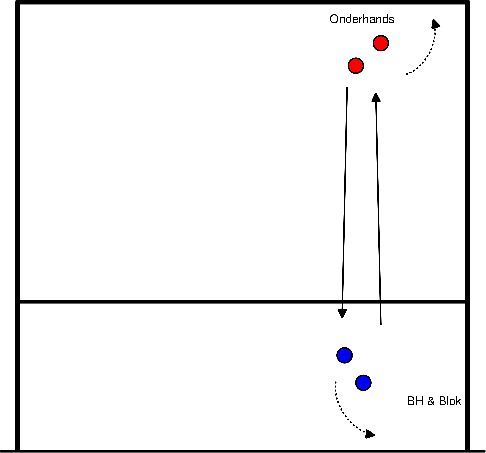
Combination of playing overhand, blocking and defending in teams of 4.
- At the net play 2 times overhead, 1 time for yourself and the next ball to the defense.
- Defense plays ball back underhand. (wide)
- After playing overhand block 2x at the net.
Extension of the exercise:
- Instead of playing the second ball overhead, hit it in a targeted way.
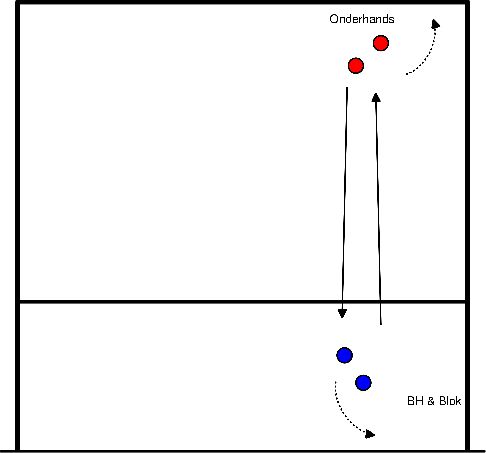
- On one side of the field there is a six in full formation.
- On the other side are 3 players.
- Behind the 3 players stand the servers.
- Exercise:
- Servers serve the ball, the 6 team defends this ball and plays out the rally.
- The 3-man team may defend and also rally.
- Point count:
- Service error, 1 point for the team that was set up.
- Ball on ground by the 3 team, point for the essayed team.
- Good service, but rally won by 3-player, point for 3-player.
- IF 3-TAL has 3 points three move on, if TEAM has 12 points, 3-tal and all servers must push up 5x.
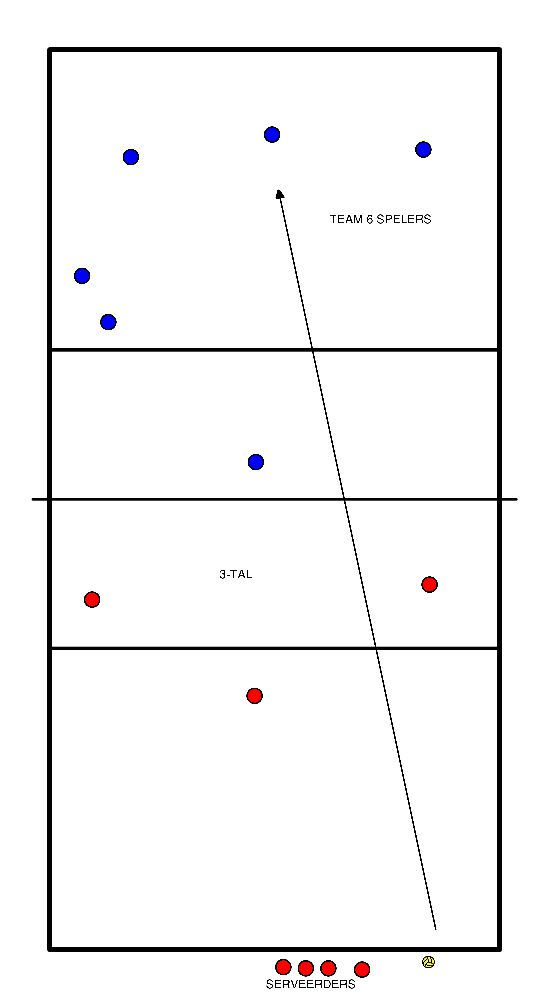
- This exercise can be done in 3 or 4 teams.
- Minimum number of players is 6 and maximum 8 per available field.
- In a 4-player team, two players on each side of the net.
- Use during the exercise half a net width per 3-4 team.
- In a 4-player team:
- 2 players on each side.
- The ball is thrown over the net at the start.
- Player A plays the ball for himself and at the 2nd contact he gives a set-up for player B.
- Player B tips the ball over the net with 1 hand.
- Player C plays the ball for himself and then gives a set-up for player D.
- D tips the ball over the net.
- After a team has played the ball over the net the players change places.
- In the case of a 3-player team:
- 2 players on one side of the net and the other player only on the other side.
- Player C has the ball and throws it over the net to the 2 team.
- Player A plays the ball for himself and at the 2nd contact he gives a set-up for player B.
- Immediately after giving the set-up, player A goes under the net.
- Player B tips the ball over the net with one hand.
- Player C plays the ball for himself and gives a set-up for player A.
- Player C goes to the other side of the net immediately after giving player A a set-up.
- Player A tips the ball over the net to player B.
- Player B plays the ball for himself and gives a set-up for player A.
- After giving the set-up player B goes under the net.
- Expansion:
- Possible mandatory blocking of tip ball by player not doing the passing.
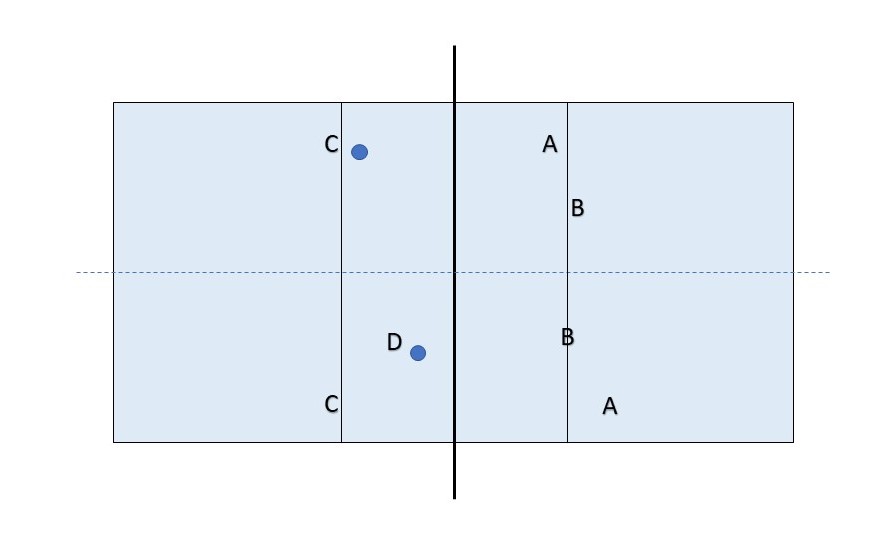
- Possible mandatory blocking of tip ball by player not doing the passing.
- Goal:
- Technically good attacks.
- Need:
- 4/5 players, enough balls.
- 1 player stands on the distributor position (between position 2 and 3).
- 1 player stands on the other side of the net to return the ball.
- 2 or 3 attackers on outside position.
- SV plays the ball directly overhand to position 4.
- 1 attacker comes in and hits straight.
- Points of Attention:
- Getting ready:
- Attacker stands outside the sideline and behind the 3-metre line.
- Play:
- Waiting for ball to come out of hands of playmaker (SV).
- Then the attacking run:
- Small step left.
- Arms forward.
- Big step right.
- Arms backwards.
- Connect left.
- Feet parallel to the net.
- Arms forward/up.
- Come out of the knees.
- Jumping.
- Stroke arm backwards (like pitcher baseball).
- Other arm pointing in direction of where you are hitting.
- ROUTINE:
- Balls are hit over the net.
- Offender gets back in line with the attackers.
- Offender other side of the net makes sure SV has enough balls.
- After a few minutes turn through until everyone has been SV.
- Getting ready:
- Organization:
- 2 players on p2 with balls.
- 2 players in the backfield.
- 2 (or more) players out of the field.
- Implementation:
- During 1 minute, the players on the p2 are going to keep the field players busy with attacks, tip balls, etc.
- Let 1 player on p2 work and as soon as a ball is not defended, the 2nd player takes over.
- The players off the field take care of ball safety.
- After 1 minute the players on p2 become defenders, defenders go out of the field and 2 new ones on p2.
- Objective:
- Increase responsiveness.
- Place one player in the corner of the field.
- Have at least 4 players stand around him in a quarter circle.
- Each player has his own ball.
- Throw the ball in tempo (tight) on the knees of the player in the corner to pass back underhand.
- After passing, immediately throw the ball to the next player in the quarter circle.
- Player in the corner so consecutive balls in underhand pass back:
- Important to stay low.
- Expect the ball.
- Respond regardless.
- About 5 rounds and then replace the player in the corner.
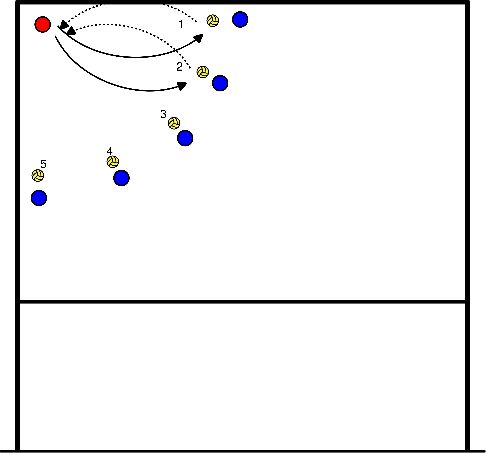
- Two players stand behind each other.
- About half a meter apart, facing the same way.
- Another player stands 3 or 4 meters away from them and has a ball and throws it to upper hand.
- The one who throws throws randomly on player 1 and 2.
- Player 1 or 2 calls loose if he thinks the ball is for him and plays overhand back.
- About 20 balls in a row.
- Then the group of 3 changes position until everyone has been there.
- After that again, but now without talking.
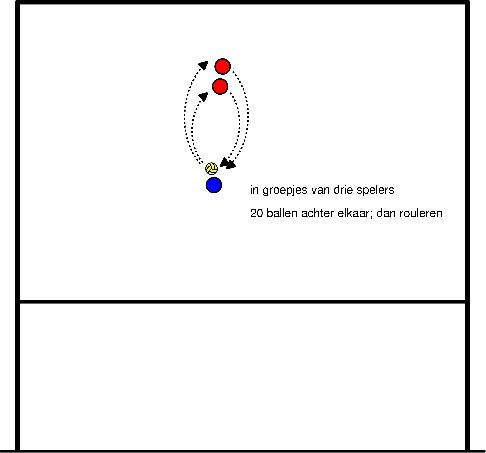
- All on the 3 meter line facing the net.
- If necessary divide in two halves.
- In slow motion synchronise the attacking pass. (right-handed)
- The next steps are in an arc towards the net; by doing this all at once in synchrony, they oblige each other to run in an arc:
- Left small step; take arms to the front; start of forward force
- Right big step; arms all the way back; deep in knees; accelerationof forward force
- Left foot in front of the right (close step), with the foot parallel to the net; forward force is slowed down
- Throw both arms up and push off with 2 feet up; forward force is converted into upward force
- Right arm backwards like baseball/arrow pitcher; left arm points in direction of desired ball path; strike ball and land through knees approx. 0.5m in front of the net
- Group on 5 and 6.
- 5 throws ball towards 3 and players on 6 set up from 3.
- Players on 5 attack on 4.
- 5 gets the ball and 6 passes to 5.
- Pay attention to high quality. Arms well up, straight up, high jumps.
- Ditto:
- But then from 6 and 1, attack on 2.
- Ditto:
- Fixed setter, players 6 play the ball BH to setter, players 5 attack on 4.
- Ditto:
- But then attack on 2, from 1.
- Variation diagonal/straight through.
- In preparation for service pass:
- Ball lane recognition.
- Organization
- 2 rows on back line on 1/6 and 6/5.
- Trainer with ball carrier on other court.
- Execution:
- Trainer serves OH alternately for one of both rows.
- Player comes in and catches the ball in the right position at navel height.
- If that goes well, reduce the escape time.
- Extension:
- Pass to receiver at 2/3.
- In preparation for attack on p3.
- Organisation:
- Player on 2/3.
- Trainer with ball pit on p5/6.
- Other players on 3m-line p3.
- Execution:
- Trainer throws ball and player on 2/3 gives a setup on3.
- Player on 3m-line runs in and catches ball and delivers it back to Tr.
- Have player on 2nd/3 set up 5 balls.
- Make sure the setup stays short on the p3 and not on the p3/4.
- Expansion:
- No more catching but attacking.








